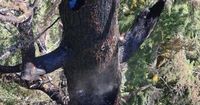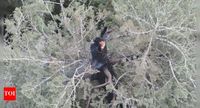Firefighters in Oregon are currently battling a rare and stubborn blaze that has engulfed the top of the historic Doerner Fir, one of the world’s tallest and oldest Douglas fir trees. The fire, first detected on August 17, 2025, has drawn national attention as crews race against time and elements to save this 450-year-old giant, which stands over 325 feet tall in the Coast Range Mountains near Coquille, about 50 miles from Coos Bay.
The Doerner Fir, with its impressive 11.5-foot diameter, has long been a magnet for hikers and tree enthusiasts. Its trail is a popular destination year-round, winding through a lush old-growth forest. But as of August 20, the trail and surrounding recreational area are closed indefinitely, with firefighting operations taking center stage and public safety a primary concern.
According to USA Today, the fire is remarkably localized, burning only within the single tree and not spreading to the dense woods nearby. Brett Weidemiller, assistant unit forester with the Coos Forest Protective Association, described the ongoing efforts: helicopters, drones, and ground-level sprinklers have all been deployed in hopes of preserving the tree and preventing the fire from escaping into the broader forest. Despite these efforts, the treetop continued to burn as of August 20, with firefighters facing significant obstacles. Falling limbs and branches, some weakened by the fire, have made it too dangerous for crews to approach the tree closely on foot.
One of the most perplexing aspects of this incident is the fire’s origin. Investigators have ruled out lightning as a cause, using advanced tracking mechanisms and time-stamped records to confirm that no strikes occurred in the area at the time the fire ignited. "We have tracking mechanisms and time-date stamps to track lightning in that area," Weidemiller told USA Today. "There was no indication of any lightning in the area at the time (the fire ignited)." With lightning off the table, the actual cause remains a mystery, and the investigation is ongoing.
As reported by the Associated Press and the BBC, the fire is burning inside the trunk itself, about 280 feet above the ground. An infrared drone flight on August 19 revealed no active flames or smoke at the very top, but significant heat lingers within a cavity deep in the trunk. Megan Harper, spokesperson for the federal Bureau of Land Management (BLM), explained the complexity: "Figuring out how to approach the tree from the side to douse the cavity with water has been a challenge." Options under consideration include building scaffolding or climbing neighboring trees to direct water into the burning cavity—no easy feat given the tree’s immense height and the dangers posed by its compromised structure.
Firefighting efforts have already made some headway. Helicopter bucket drops have reduced fire activity near the top, while sprinklers and containment lines have been established at the base to prevent the fire from spreading. A helicopter remains on standby for additional water drops if needed, according to the Coos Forest Protective Association and BLM. However, the fire has already taken a toll on the tree itself. Both Harper and Weidemiller confirmed that the Doerner Fir has lost between 50 and 70 feet from its top—damage caused both by the fire and by pieces falling away from the weakened crown.
"We've lost about 50 feet of it, just from fire and pieces falling out," Harper told the BBC and CBS affiliate KCBY-TV. "So I don't know where it'll stand after this, but it's still a magnificent tree." The loss may impact the Doerner Fir’s standing in global height rankings, but its status as a natural wonder and local treasure remains undiminished in the eyes of many.
Despite the dramatic nature of the blaze, officials are cautiously optimistic that the tree is not at immediate risk of total destruction. Harper reassured the public, stating, "The tree is so big, it's got so much mass that it would take a while for it to burn all the way through the tree." This assessment is echoed by other forestry officials, who note that the sheer size and density of the Doerner Fir provide a buffer against rapid, catastrophic loss—even as the fire continues to smolder within its trunk.
The weather, unfortunately, has not been on the firefighters’ side. Hotter and drier conditions have dominated the region in recent days, creating a challenging environment for suppression efforts and increasing the risk of further damage if the fire is not brought under control soon. The Coos Bay District has issued an emergency closure of public lands in the vicinity of the firefighting operation, underscoring the seriousness of the situation and the need to keep both the public and crews safe.
The Doerner Fir’s ordeal has struck a chord with locals and nature lovers far beyond Oregon. As Harper put it, "I think people really love it. There's a lot of history there, and so we don't want to lose it." The tree, estimated to have taken root in the early 16th century, has witnessed centuries of change in the Pacific Northwest. Its towering presence is a testament to the resilience of old-growth forests, and its current plight is a stark reminder of the vulnerability of even the mightiest living things.
While the cause of the fire remains unknown, the singular nature of the incident—only the Doerner Fir is burning in the immediate area—has heightened the sense of mystery and urgency. Investigators with the BLM continue to search for answers, while crews on the ground and in the air remain focused on saving what they can of this ancient giant.
For now, the world watches and waits as Oregon’s firefighters, scientists, and conservationists confront a challenge as tall as the tree itself. The fate of the Doerner Fir hangs in the balance, but the dedication to its preservation speaks volumes about the value placed on natural heritage and the lengths people will go to protect it. With the fire still smoldering within its massive trunk, the next few days will be critical in determining whether this legendary tree can weather yet another storm—or if it will become a somber symbol of loss in a changing climate.
The Doerner Fir’s story is still unfolding, but the collective efforts to save it reflect a deep respect for the past and a hope that future generations might still walk its trail and marvel at its grandeur.


